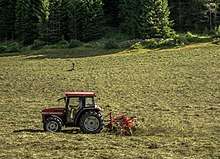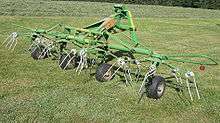Tedder (machine)
A tedder (also called hay tedder) is a machine used in haymaking. It is used after cutting and before windrowing, and uses moving forks to aerate or "wuffle" the hay and thus speed up the process of hay-making. The use of a tedder allows the hay to dry ("cure") better, which results in improved aroma and color.[1]


History
Robert L. Ardrey, American Agricultural Implements[2]
The tedder came into use in the second half of the nineteenth century.[3] While Charles Wendel claims in his Encyclopedia of American farm implements & antiques that the machine wasn't introduced to the United States until the 1880s,[4] there are enough indications that the tedder was in use in the 1860s—The New York Times reports on its efficacy in 1868,[5] and in that same year the Annual Report of the Commissioner of Agriculture in Maine comments on the American-made Hubbard's hay tedder, which had been on the market since 1863; according to the Maine report, in 1859 the machine was "an implement lately imported from England."[6]
The action of the tedder is described, in the late 19th and early 20th century, as being used to "stir"[7] or "scatter"[8] cut hay in the field.
Operation
The original tedder is a farm tool on two wheels pulled by a horse; the rotation of the axle drives a gear which operates a "number of arms with wire tines or fingers at the lower ends."[9] The tines pick up the hay and disperse it; usually, the height at which the tines pick up the hay can be adjusted.
In an early, simple hay tedder described in 1852 and manufactured in Edinburgh by the company of Mr. Slight, the two wheels, via a spur wheel and a pinion, drive a set of light wheels, the "rake wheels"; on these two rake wheels are mounted eight rakes, which pick up and disperse the hay.[10] A later "English hay-tedder" uses two separate cylinders with rotating forks that can be reversed to lay the hay down lightly for improved exposure to air.[11]
American machines, such as those made by Garfield, by Mudgett, and by Bullard (Ezekiel W. Bullard of Barre, Massachusetts, is credited in one source with the invention of the machine, nicknamed "the grasshopper"),[12] typically used a system with a revolving crank in the middle of the arm and a lever at the upper end,[9] or a system whereby rotating wheels moved the forks up and down.[13] The first tedder widely available on the American market was the already mentioned Bullard's Hay Tedder, which had forks moving up and down on a compound crank, working in a motion described as "the energetic scratching of a hen." The American Hay Tedder, made by the Ames Plow Company of Boston and described in 1869 as a "new machine, remarkable for its simplicity and perfection of working, was more like the British machine in its rotational operation.[14]
Some tedders have the rotating tines enclosed inside a solid structure to increase the force applied to the hay. Other similar machines included the wuffler and the acrobat.[15] The wuffler shuffles the hay in a manner similar to the tedder. The acrobat may be used also for turning, and for rowing hay up ready for baling.
Centrifugal rakes

On two opposing horizontal gyroscopes, which are pto-driven, are mounted obliquely downward standing tines. These refer to the green waste and throw it back. Due to the rear-mounted collecting baskets a windrowing is as possible with a Rake. Their distribution is low because of the limited job performance.[16]
Use and importance

Its development was of great importance to agriculture, since it saved labor and thus money:[17] using a tedder, a man and a horse could do as much work as fifteen laborers.[18] It also resulted in greater economy, since cut grass could be turned into hay the same day[19] even if it had become wet or been trampled by horses [20] and before its nutritional value could be reduced by repeated soaking from rain. Especially in humid areas (such as the Eastern United States), the invention of the tedder added greatly to improved hay production from such crops as alfalfa[21] and clover,[1][22] and allowed for haying while the grass was still green[5] which produced hay of much higher value.[6]
See also
References
- Bailey, Liberty Hyde (ed.) (1907). Cyclopedia of American Agriculture: Farms. Macmillan. pp. 205–206.CS1 maint: extra text: authors list (link)
- Ardrey, Robert L. (1894). American agricultural implements: a review of invention and development in the agricultural implement industry of the United States. Chicago: Robert L. Ardrey. p. 98.
- Walker, Joseph B. (October 1887). "The Progress of New England Agriculture During the Last Thirty Years". New Englander and Yale Review. 47: 233–44. Retrieved 2009-09-13. p. 239.
- Wender, Charles H. (2004). Encyclopedia of American farm implements & antiques. Krause. p. 257. ISBN 978-0-87349-568-4.
- "The Hay Crop and the Haying Season" (PDF). The New York Times. 1868-06-26. Retrieved 2009-09-13.
- Agriculture of Maine: Annual Report of the Commissioner of Agriculture. Augusta: Maine Dept. of Agriculture. 1868. pp. 236–38.
- Knight, Edward Henry (1884). Knight's new mechanical dictionary: A description of tools, instruments, machines, processes, and engineering. With indexical references to technical journals (1876–1880.). Houghton, Mifflin and company. p. 449.
- Mr. George Clark of Higganum, speaking before the Connecticut State Board of Agriculture in December 1903, insisted that the tedder is a heaping machine rather than a spreading machine. Connecticut State Board of Agriculture (1904). Annual report of the secretary of the Connecticut State Board of Agriculture, Volume 37. Press of Case, Lockwood and Co. p. 147.
- Davidson, Jay Brownlee; Leon Wilson Chase (1908). Farm machinery and farm motors. New York: Orange Judd. pp. 174–75.
- Stephens, Henry (1852). The Book of the Farm, Volume 2. Edinburgh and London: W. Blackwood. pp. 228–29.
- Knight, Edward Henry (1881). Knight's American mechanical dictionary: A description of tools, instruments, machines, processes, and engineering; history of inventions; general technological vocabulary; and digest of mechanical appliances in science and the arts, Volume 3. Houghton, Osgood and company. pp. 2503–2504.
- Pierce, Frederick Clifton (1899). Foster genealogy, Part 2. Chicago: W.B. Conkey. p. 755.
- Flint, Charles Louis (1892). American farming and stock raising: with useful facts for the household, devoted to farming in all its departments. New York: Casselberry. pp. 240–41.
- Thomas, John Jacob (1869). Farm implements and farm machinery, and the principles of their construction and use: with simple and practical explanations of the laws of motion and force as applied on the farm. New York: Orange Judd. pp. 165–66.
- Vintage Collection – Non-Ferguson Implements at rhoddssfarm.co.uk
- http://www.hoftechnik.at/zetten-heuwender-kreiselheuer/
- Allen, Richard Lamb (1869). New American farm book. New York: Orange Judd. pp. 127–28.
- "Agriculture, sec. 14: Haymaking". Encyclopedia. R.S. Peale. 1890. p. 379. Available online.
- Hunter, Robert; John Alfred Williams; Sidney John Hervon Heritage (1897). The Supplementary Cyclopedia of Universal Knowledge; supplement to The American encyclopaedic dictionary: a work of reference to the English language defining over 250,000 words. Chicago and New York: R.S. Peale and J.A. Hill. p. 18.
- Sanford, Albert Hart (1916). The story of agriculture in the United States. D.C. Heath. pp. 252–53. See also the entry "American Farm Implements" in Beach, Frederick Converse; George Edwin Rines (1912). The Americana: a universal reference library, comprising the arts and sciences, literature, history, biography, geography, commerce, etc., of the world, Volume 1. Scientific American compiling department. pp. 283–86.
- Kansas State Board of Agriculture (1894). Report of the Kansas State Board of Agriculture. Topeka: Edwin H. Snow. p. 37.
- Michigan State Board of Agriculture (1868). Report of the secretary, Volume 7. Lansing: John A. Kerr. p. 223.
External links
![]()
.png)